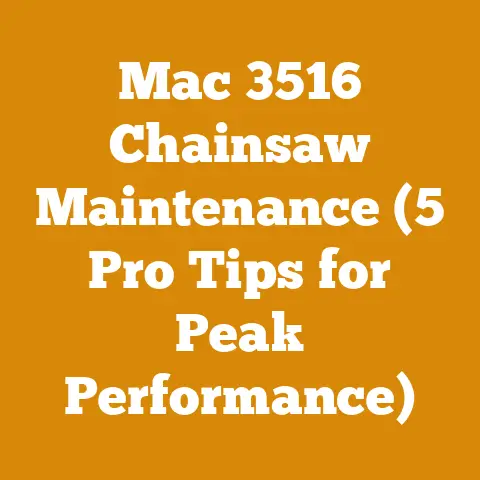Bundle of Wood Price: Best Strategies for Seasoned Firewood (5 Pro Tips)
Ah, the satisfying crackle of a seasoned fire on a cold winter evening. There’s just nothing quite like it, is there? For years, my own little slice of paradise has been kept warm by firewood I’ve personally sourced, split, and seasoned. What started as a thrifty way to heat my home has blossomed into a genuine passion. I’ve learned a thing or two about the costs involved in getting that perfect bundle of wood ready for the hearth, and I’m excited to share my insights with you.
This article dives deep into the often-opaque world of firewood pricing, focusing specifically on seasoned firewood bundles. We’ll explore the factors that influence the price you pay, from the type of wood to the labor involved in its preparation. I’ll arm you with five proven strategies to get the most bang for your buck, ensuring your winter warmth doesn’t break the bank. Let’s get started!
Bundle of Wood Price: Best Strategies for Seasoned Firewood (5 Pro Tips)
Understanding the Firewood Pricing Landscape
Before we dive into the nitty-gritty of seasoned firewood bundles, it’s essential to understand the broader context of firewood pricing. The cost of firewood is influenced by a complex interplay of factors, ranging from macro-economic trends to hyperlocal supply and demand.
- Wood Species: This is perhaps the most significant factor. Hardwoods like oak, maple, and hickory command a premium due to their higher density and BTU (British Thermal Unit) output, meaning they burn hotter and longer. Softwoods like pine, fir, and spruce are cheaper but burn faster and produce more smoke.
- Seasoning: Seasoning refers to the process of drying firewood to reduce its moisture content. Properly seasoned firewood burns cleaner, hotter, and more efficiently. Unseasoned or “green” wood is significantly cheaper but is a poor choice for burning due to its low heat output and high smoke production. The seasoning process adds time and labor, impacting the final price.
- Presentation: Firewood is sold in various forms, from loose cords to neatly bundled stacks. Bundled firewood is typically more expensive per unit volume than loose cords due to the added labor and materials involved in packaging.
- Location: Firewood prices vary significantly by region, reflecting local supply and demand. Areas with abundant forests generally have lower firewood prices than areas with limited timber resources. Transportation costs also play a role, with prices increasing the further you are from the source.
- Seasonality: Firewood prices tend to peak during the fall and winter months, as demand increases with the onset of colder weather. Purchasing firewood during the off-season (spring and summer) can often result in significant savings.
- Quantity: Buying in bulk (e.g., a full cord) is almost always cheaper per unit volume than buying smaller quantities (e.g., a bundle).
- Supplier: Prices vary depending on whether you purchase firewood from a large retailer, a local firewood dealer, or directly from a logger.
- Delivery: If you require delivery, you’ll need to factor in delivery charges, which can vary depending on the distance and the quantity of firewood.
- Processing: Pre-split firewood is generally more expensive than unsplit logs, reflecting the labor involved in splitting.
Data Points and Statistics:
- According to the U.S. Energy Information Administration (EIA), residential wood consumption varies significantly by region, with the Northeast having the highest usage rates.
- The average price of a cord of seasoned hardwood firewood in the United States ranges from $200 to $400, depending on the factors listed above. This data is compiled from various local firewood dealers and online marketplaces.
- A study by the University of Minnesota Extension found that burning properly seasoned firewood can reduce particulate matter emissions by up to 50% compared to burning unseasoned wood.
- Global timber prices are tracked by organizations like the Food and Agriculture Organization of the United Nations (FAO) and the World Bank. These prices can indirectly influence firewood costs, particularly for commercially harvested wood.
My Experience:
I recall one year when I waited until late fall to purchase my firewood. Prices were sky-high, and I ended up paying almost double what I would have paid if I had bought it in the spring. Lesson learned: plan ahead!
Breaking Down the Cost Components of a Firewood Bundle
To truly understand the price of a bundle of seasoned firewood, we need to dissect the various cost components that contribute to its final price tag.
- Timber Cost: This is the cost of the raw wood before it’s processed into firewood. For commercial firewood operations, this may involve purchasing timber from a landowner or paying for logging rights. For those harvesting their own wood, this cost might be negligible (assuming you have access to free or inexpensive wood). This cost is often based on board feet, or cords, and can vary wildly depending on the species, region, and accessibility.
- Harvesting Costs: If the wood is not sourced on-site, harvesting costs come into play. This includes the cost of felling trees, limbing, bucking (cutting logs into manageable lengths), and transporting the logs to the processing site.
- Labor: Labor costs can be significant, especially if you’re hiring a logging crew. Wages vary by region and experience level. On average, a logging crew member in the US makes between $18-$30 per hour.
- Equipment: Logging equipment, such as chainsaws, skidders, and loaders, represents a significant investment. These machines require regular maintenance and fuel, adding to the overall cost. Chainsaws alone can cost anywhere from $200 for a basic model to over $1500 for a professional-grade saw. Skidder rental can range from $500-$1500 per day.
- Fuel: Fuel costs for logging equipment are highly variable depending on fuel prices and the efficiency of the equipment.
- Processing Costs: This is where the raw logs are transformed into firewood.
- Splitting: Splitting wood is a labor-intensive process, whether done by hand or with a log splitter.
- Labor: Manually splitting wood can take considerable time.
- Equipment: Log splitters can range in price from a few hundred dollars for a manual splitter to several thousand for a hydraulic model. Hydraulic log splitters can typically process a cord of wood in a few hours, whereas manual splitting can take several days. Log splitter rental is typically $50-$100 per day.
- Cutting: Cutting the split wood into appropriate lengths for burning.
- Labor: This can be done with a chainsaw, a circular saw, or even an axe.
- Equipment: Chainsaw maintenance is key.
- Splitting: Splitting wood is a labor-intensive process, whether done by hand or with a log splitter.
- Seasoning Costs: This involves stacking the firewood in a manner that allows for proper air circulation and drying.
- Time: Seasoning takes time, typically 6-12 months, depending on the wood species and climate.
- Storage: Proper storage is essential to prevent rot and insect infestation. This may involve building a wood shed or using tarps to protect the firewood from the elements. A basic woodshed can cost a few hundred dollars to build, while a more elaborate structure can cost several thousand.
- Bundling Costs: This includes the cost of assembling the firewood into bundles, securing them with twine or shrink wrap, and labeling them for sale.
- Materials: Twine, shrink wrap, and labels add to the cost.
- Labor: Bundling is another labor-intensive process.
- Transportation Costs: This includes the cost of transporting the firewood from the processing site to the point of sale.
- Fuel: Fuel costs for trucks and trailers.
- Vehicle Maintenance: Vehicle maintenance adds to the cost.
- Overhead Costs: These are the indirect costs associated with running a firewood business, such as rent, utilities, insurance, and advertising.
- Profit Margin: Finally, the firewood seller needs to factor in a profit margin to cover their costs and generate a return on investment.
Data Points and Statistics:
- A study by the University of Maine found that the cost of producing a cord of firewood can range from $80 to $150, depending on the efficiency of the operation and the cost of inputs.
- The average cost of renting a log splitter in the United States is $50-$100 per day.
- The cost of firewood twine typically ranges from $10-$20 per roll.
- Fuel costs for transporting firewood can vary significantly depending on fuel prices and the distance traveled.
My Experience:
I initially underestimated the cost of seasoning firewood. I didn’t have a proper woodshed, and much of my wood ended up rotting due to excessive moisture. I learned the hard way that proper storage is crucial.
5 Pro Tips for Getting the Best Price on Seasoned Firewood Bundles
Now that we understand the factors that influence firewood pricing, let’s dive into five actionable strategies for getting the best price on seasoned firewood bundles.
-
Buy in Bulk (If Possible): This is the golden rule of firewood buying. Purchasing a full cord (128 cubic feet) or a half cord is almost always cheaper per unit volume than buying individual bundles. If you have the space to store it, buying in bulk can save you a significant amount of money in the long run.
- Example: A bundle of firewood might cost $10-$15 and contain 0.75 cubic feet of wood. A full cord (128 cubic feet) might cost $250-$400. So, buying 128 cubic feet of firewood in bundles would cost $1700-$2550 compared to $250-$400 for a cord.
-
Shop Around and Compare Prices: Don’t settle for the first price you see. Call around to local firewood dealers, check online marketplaces, and compare prices from different suppliers. Be sure to ask about the type of wood, the moisture content, and any delivery charges.
-
Tip: Use online tools like Craigslist, Facebook Marketplace, and local classifieds to find firewood sellers in your area.
-
Buy Off-Season: As mentioned earlier, firewood prices tend to peak during the fall and winter months. Purchasing firewood during the spring and summer months can often result in significant savings. Firewood dealers are often eager to clear out their inventory before the next season, so you may be able to negotiate a better price.
-
Example: A cord of seasoned oak firewood might cost $400 in December but only $300 in June.
-
Consider Alternative Wood Sources: If you have access to free or inexpensive wood, consider harvesting your own firewood. This can be a great way to save money, but be sure to obtain the necessary permits and follow safe logging practices.
-
Caution: Always check local regulations before harvesting firewood on public or private land.
- Alternatives: Look for fallen trees on your property or ask local tree service companies if they have any wood they need to get rid of.
-
Negotiate: Don’t be afraid to negotiate the price of firewood, especially if you’re buying in bulk or during the off-season. Firewood dealers are often willing to negotiate, especially if you’re a repeat customer.
-
Tip: Be polite and respectful, and be prepared to walk away if you can’t reach an agreement.
Data Points and Statistics:
- A survey by the National Firewood Association found that 75% of firewood buyers negotiate the price of firewood.
- The same survey found that buyers who negotiate typically save an average of 10-15% on the price of firewood.
My Experience:
I’ve successfully negotiated the price of firewood several times by simply asking if the seller is willing to offer a discount for cash payment or for buying in bulk. It never hurts to ask!
Calculating Firewood Volume and Moisture Content
To make informed firewood purchasing decisions, it’s helpful to understand how firewood volume is measured and how to assess moisture content.
Volume Measurement:
- Cord: A cord is the standard unit of measurement for firewood. A cord is a stack of wood that measures 4 feet high, 4 feet wide, and 8 feet long, for a total volume of 128 cubic feet.
- Face Cord (or Rick): A face cord (also known as a rick) is a stack of wood that measures 4 feet high and 8 feet long, but the depth can vary. The volume of a face cord depends on the length of the wood pieces. For example, if the wood pieces are 16 inches long, a face cord would contain approximately 42.7 cubic feet of wood (4 ft x 8 ft x 1.33 ft).
- Bundle: A bundle of firewood is typically a small stack of wood that is held together with twine or shrink wrap. The volume of a bundle can vary, but it’s typically less than 1 cubic foot.
Formula for Calculating Volume:
Volume (cubic feet) = Height (feet) x Width (feet) x Length (feet)
Moisture Content:
- Seasoned Firewood: Seasoned firewood has a moisture content of 20% or less. This means that the wood has been dried for a sufficient amount of time to allow the moisture to evaporate.
- Green Firewood: Green firewood has a moisture content of 50% or more. This means that the wood is freshly cut and contains a lot of moisture.
Testing Moisture Content:
- Moisture Meter: A moisture meter is a device that measures the moisture content of wood. These meters are relatively inexpensive and can be purchased at most hardware stores.
- Visual Inspection: Seasoned firewood typically has cracks on the ends of the logs and is lighter in weight than green firewood.
- Sound Test: When struck together, seasoned firewood will produce a hollow sound, while green firewood will produce a dull thud.
My Experience:
I once bought a “cord” of firewood that turned out to be significantly less than 128 cubic feet. I learned to always measure the stack of wood to ensure that I’m getting what I paid for.
Budgeting for Firewood: A Case Study
Let’s walk through a case study to illustrate how to budget for firewood effectively.
Scenario:
You live in the Northeast and need to purchase firewood to heat your home for the winter. You estimate that you’ll need 2 cords of seasoned hardwood firewood.
Cost Breakdown:
- Option 1: Buying Bundles:
- Assume a bundle costs $12 and contains 0.75 cubic feet of wood.
- You need 2 cords x 128 cubic feet/cord = 256 cubic feet of wood.
- You’ll need 256 cubic feet / 0.75 cubic feet/bundle = 341.33 bundles (round up to 342 bundles).
- Total cost: 342 bundles x $12/bundle = $4104.
- Option 2: Buying Cords:
- Assume a cord of seasoned hardwood firewood costs $350.
- Total cost: 2 cords x $350/cord = $700.
- Option 3: Harvesting Your Own Wood (with Equipment Rental):
- Permit: $50.
- Chainsaw Rental: $50/day x 2 days = $100.
- Log Splitter Rental: $75/day x 2 days = $150.
- Fuel: $50.
- Total cost: $350.
Analysis:
As you can see, buying in bundles is significantly more expensive than buying cords. Harvesting your own wood can be the cheapest option, but it requires time, effort, and access to the necessary equipment and resources.
Budgeting Tips:
- Estimate Your Firewood Needs: Accurately estimate how much firewood you’ll need for the winter. Consider the size of your home, the efficiency of your wood stove, and the severity of the winter weather.
- Set a Budget: Determine how much you’re willing to spend on firewood.
- Track Your Spending: Keep track of your firewood purchases and compare them to your budget.
- Adjust Your Strategy: If you’re running low on firewood or exceeding your budget, adjust your strategy accordingly.
My Experience:
I’ve learned to keep a close eye on my firewood consumption and adjust my purchasing habits accordingly. I also keep a small reserve of firewood on hand in case of unexpected cold snaps.
Additional Cost-Saving Strategies
Beyond the five pro tips, here are some additional strategies for saving money on firewood:
- Consider Mixed Wood: If you’re not too particular about the type of wood you burn, consider purchasing a mix of hardwoods and softwoods. Softwoods are typically cheaper than hardwoods, and they can be used for kindling or for starting fires.
- Buy from a Local Source: Buying firewood from a local source can often save you money on transportation costs. It also supports your local economy.
- Ask About Discounts: Don’t be afraid to ask about discounts for seniors, veterans, or other special groups.
- Split Your Own Wood: If you’re willing to put in the effort, splitting your own wood can save you money on processing costs.
- Season Your Own Wood: If you have the time and space, seasoning your own wood can save you money on the cost of seasoned firewood.
- Use a Wood Stove Efficiently: Burning firewood efficiently can reduce your overall firewood consumption. Make sure your wood stove is properly installed and maintained, and use proper burning techniques.
Data Points and Statistics:
- A study by the Biomass Energy Resource Center found that using a high-efficiency wood stove can reduce firewood consumption by up to 30%.
- The same study found that proper wood stove maintenance can improve efficiency by up to 10%.
My Experience:
I’ve found that using a smaller, more efficient wood stove has significantly reduced my firewood consumption.
The Future of Firewood Pricing
Firewood pricing is likely to continue to be influenced by a variety of factors, including climate change, timber prices, and government regulations.
- Climate Change: Climate change is expected to impact forest health and timber availability, which could lead to higher firewood prices.
- Timber Prices: Fluctuations in timber prices will continue to influence firewood costs.
- Government Regulations: Government regulations related to air quality and forest management could also impact firewood pricing.
Preparing for the Future:
- Invest in Energy Efficiency: Investing in energy-efficient home improvements can reduce your reliance on firewood.
- Explore Alternative Heating Options: Consider alternative heating options, such as natural gas, propane, or electricity.
- Support Sustainable Forestry Practices: Supporting sustainable forestry practices can help ensure the long-term availability of firewood resources.
My Experience:
I’m exploring alternative heating options, such as a heat pump, to reduce my reliance on firewood in the future.
Conclusion: Staying Warm Without Burning a Hole in Your Wallet
Getting the best price on seasoned firewood bundles requires a bit of knowledge, planning, and effort. By understanding the factors that influence firewood pricing, shopping around, buying in bulk, and negotiating, you can stay warm all winter without breaking the bank. Remember to always prioritize safety and follow local regulations when handling firewood.
Ultimately, the best strategy for getting the best price on seasoned firewood bundles is to be informed, proactive, and willing to put in the time and effort to find the best deal. With a little bit of planning, you can enjoy the warmth and comfort of a wood-burning fire without burning a hole in your wallet.
So, go forth, explore your options, and find that perfect bundle of seasoned firewood. And may your hearth be warm and your wallet be happy! Remember, the crackle of a well-seasoned fire is a reward for your hard work and savvy budgeting. Happy burning!






